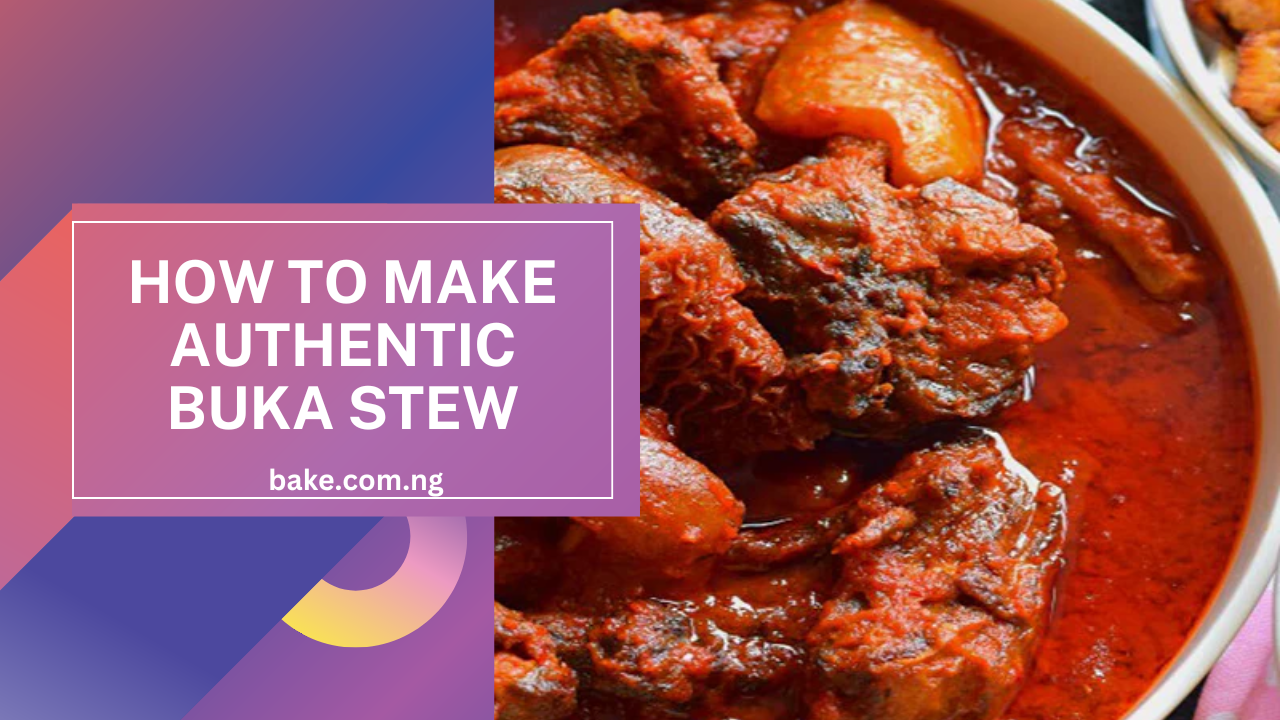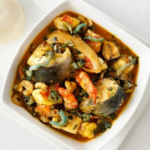If you’ve ever eaten at a roadside buka (local eatery) or a “mama put” joint in Nigeria, then you’ve likely tasted that unforgettable red stew that coats your rice or swallow with magic. That’s Buka Stew – rich, smoky, deeply flavored, and unapologetically oily. This stew is not just a meal; it’s a cultural experience.
In this post, you’ll learn how to recreate that authentic buka stew from the comfort of your kitchen, with all the flavor and aroma that keeps people going back to the same buka for years.
What Is Buka Stew?
Buka Stew, also called Ayamase red stew or Mama Put stew, is a traditional Nigerian tomato-based stew. It stands out for its:
- Smoky, deep flavor
- Rich palm oil base
- Peppery kick
- Unique seasoning (using iru, aka locust beans)
- Use of assorted meats and beef stock
It’s a favorite accompaniment for white rice, boiled yam, plantain, or any Nigerian swallow. While each buka may have its own twist, this recipe captures the essence of the classic.
Ingredients You’ll Need
Here’s a list of ingredients for a full pot of Buka Stew (serves 6–8):
For the stew base:
- 6 large fresh tomatoes
- 3 large tatashe (red bell peppers)
- 2–3 scotch bonnet (ata rodo) peppers (adjust to taste)
- 1 large onion (divided – half for blending, half for frying)
- 1 tablespoon locust beans (iru) – optional but recommended
- 1 tablespoon tomato paste (for color depth)
Oils & seasonings:
- 1 cup palm oil (do not reduce – this is key to the stew’s flavor)
- ¼ cup vegetable oil (helps balance the palm oil)
- 3 seasoning cubes (e.g., Knorr or Maggi)
- 1 teaspoon thyme
- 1 teaspoon curry powder
- 1 teaspoon salt (to taste)
- 1 teaspoon ground crayfish (optional but authentic)
Proteins:
- 1 kg assorted meats (beef, tripe, cow foot, kidney, liver – your choice)
- 1 smoked fish or dried fish (deboned)
- Beef stock (from your cooked meat)
Preparation Steps
Step 1: Prepare Your Meats
- Wash and season your assorted meats with salt, seasoning cubes, onions, and thyme.
- Boil until tender. You can separate tougher cuts like cow leg and tripe to cook longer.
- Once done, reserve the beef stock – you’ll need it for the stew.
- Fry or grill the meat slightly to add more texture and flavor (optional but adds authenticity).
Step 2: Blend the Peppers
- Blend the tomatoes, tatashe, scotch bonnet, and half of the onion into a rough paste. Avoid making it too smooth – that grainy texture is part of the buka feel.
- Pour the blended mix into a pot and boil for 10–15 minutes to reduce the water content. The paste should be thick, not watery.
Step 3: Bleach the Palm Oil
Important: Do this step with caution and ventilation.
- Pour the palm oil into a deep pot and bleach it on medium heat for 10–15 minutes until it turns golden and stops smoking.
- You’ll know it’s ready when the strong palm oil smell reduces and the color becomes lighter.
- Add the vegetable oil and let the temperature drop slightly.
Tip: Cover the pot loosely with a lid or foil while bleaching to avoid oil splatter. Do not leave it unattended.
Step 4: Fry the Onions & Locust Beans
- Add the chopped onions and fry until translucent.
- Add the locust beans (iru) and stir – this adds that distinct buka aroma.
- Let it fry for 2–3 minutes.
Step 5: Add Tomato Paste and Fry
- Stir in the tomato paste and let it fry in the oil for 3–5 minutes until the raw taste disappears.
- This step deepens the red color and adds body to the stew.
Step 6: Add Blended Pepper Mix
- Pour in the reduced blended pepper mix.
- Stir and fry for 20–30 minutes, stirring occasionally to prevent burning.
- The stew should begin to separate from the oil (i.e., the oil floats on top) and smell “buka-level” good.
Step 7: Add Meat Stock and Seasonings
- Pour in your beef stock (about 1–2 cups).
- Add your seasoning cubes, crayfish, thyme, curry, and salt to taste.
- Stir and simmer on low heat for another 10–15 minutes.
Step 8: Add Meats and Fish
- Add your fried meats and smoked fish to the stew.
- Stir gently to combine.
- Cover and simmer for another 5–10 minutes so the flavors fully meld.
Signs Your Buka Stew Is Ready
- Deep red color
- Oil floating on top
- Rich, smoky aroma
- The stew is thick but spoonable
- Meats are well-coated in the sauce
What to Serve With Buka Stew
Buka stew is incredibly versatile. Serve it with:
- White rice
- Boiled yam
- Plantains (boiled or fried)
- Eba, Amala, Semo, or Pounded Yam
- Agidi or Moi Moi
Pro Tips for Perfect Buka Stew
- Don’t skip the bleaching of palm oil – that’s where the smoky base comes from.
- Use locust beans if you can find them; they add real depth.
- Don’t reduce the oil too much – buka stew is meant to be rich!
- Fry your pepper base well – raw stew is a no-no.
- Store leftovers in the fridge – it actually tastes better the next day!
Variations
- Chicken Buka Stew: Swap the beef for boiled and fried chicken.
- Vegetarian Buka Stew: Skip the meats and load up on mushrooms, tofu, or boiled eggs.
- Spicy Buka Stew: Add more ata rodo or cayenne pepper.
- Buka Jollof Hack: Add cooked rice directly into the stew base and stir – boom, smoky jollof vibes.
Final Thoughts
Buka stew is more than just a tomato sauce – it’s an explosion of Nigerian street flavor in one pot. When done right, it will transport you straight to the busy buka stalls of Lagos or Onitsha, where the air smells of pepper and grilled meat, and flavors speak louder than words.
Take your time with each step, and you’ll be rewarded with a pot of gold – literally and figuratively.








